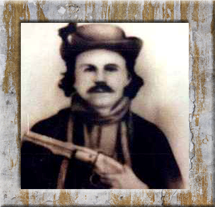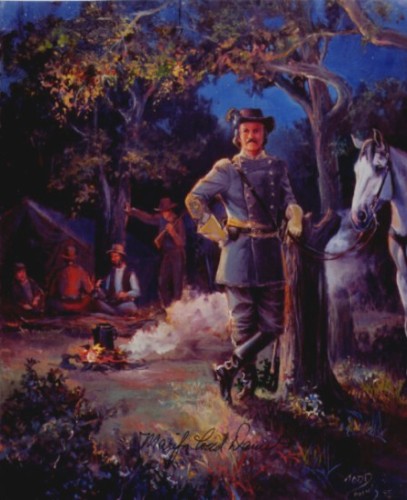
THE LEE-PEACOCK FEUD By W.W.Sherrell and pub. 1980 Page 14-15 In the
southwestern
part of Fannin County, in the northwestern part of Hunt, in the
southeastern
part of Grayson and the northeastern part of Collin counties, there was
an area covered by thickets of various names. These thickets
were
known as Mustang Thicket, Black Jack Thicket, Wildcat Thicket, Jernigan
Thicket and some times as the Big Thicket. As late as 1877
there
was a dense thicket about seven miles long and a maximum width of four
miles south of the present town of Leonard, into which few
people
had penetrated and through which only one man had ever gone. During the
Civil War these thickets were the rendezvous of army deserters,
slackers,
and fugitives.
In the northern part of one of these thickets whose southern boundary was the Fannln-Hunt county line, Daniel W. Lee (1810-1877) patented a track of land and there built his home and reared his family. Daniel W. Lee 
Captain Bob Lee The Union League, an organization led by the Freedman's Bureau, carpet- baggers and scalawags, with Federal support, had its North Texas headquarters at Pilot Grove, about seven miles from the home of the Lee families. The leader of the Union League was Lewis Peacock, whose home was south of Pilot Grove on the Fannin-Grayson County line. He had arrived in Texas in 1856. It was not long until the news of Bob Lee's return was known everywhere in the Red River Valley. The Confederate veterans were happy about it, for now they felt they had a leader. To Peacock, Captain Bob Lee, the cavalryman, with his good clothes, his plumed hat and gold coins, was too big for the "Corners" and would have to go. Peacock and other members of the Union League conceived the idea of extorting money from Bob Lee. They came to his house one night and arrested him and started to Sherman with him, but stopped in Choctaw Creek bottoms. They took Lee's watch and $200 in gold and he and his father, Daniel W. Lee, were to sign a note for $2,000. Bob Lee was released. The Lees refused to pay the note. Suit was brought in Bonham and the Lees won the case. The robbery in Choctaw Creek bottoms started the Lee-Peacock War. During the latter part of 1867, all of 1868, and until June, 1869, the war raged. All told something like 50 men would be killed. By the summer of 1868 the war had gotten so hot that the Union League called for help from the Federal Government. On August 27, 1868, General J. J. Reynolds issued a notice of a reward of $1,000 cash to be paid for the delivery of Bob Lee to the Post Commander at Austin, or Marshall, Texas. Bob Lee did what many others had already done: he built a hide-out in the brush, In late February, 1867, Bob Lee was in Pilot Grove. In a local store he ran across Jim Maddox, a Union man suspected of being in the party that had kidnapped Lee. Bob Lee offered Maddox a gun so they could fight. Maddox declined Lee's offer. Later in the day Lee was standing on the street and Maddox slipped up behind him and shot him in the back of the head. Lee was knocked unconscious. He was taken to Dr. William H. Pierce, who patched him up in his home and tended him until Lee was able to go home. This caused much anger among the Peacock gang w ho then killed Dr. Pierce. On February 24, 1867, Dr. Pierce was called to his door and shot to death by Hugh Hudson, a known Peacock man. Hugh Hudson, according to a theory by Dr. W. C. Holmes, who had taken over Dr. Pierce's practice, was killed at Saltillo, a teamster's stop on the road to Jefferson. Dr. Holmes was called on to identify a man said to be Hudson. The description met that of Hudson. One day early in the spring of 1868 Elijah Clark, a Peacock man, called on Hester Anne Dixon to invite her to go with him to a dance. She refused him. In his frustration and disappointment, he ran out of the house without his gun which he had left on a table. He met Hester Anne's brother, 16-year-old Billy Dixon, a Lee man; Elijah grabbed Billy's gun and shot at him, Billy ran in the house, grabbed Elijah's gun and ran out of the house and shot Elijah off his horse, dead. In less than a month, Billy Dixon met death on the Jefferson Road. He was on the way to Jefferson with a load of cotton when about 20 miles from home the wagon broke down. His cousin, Charlie Dixon, was with him. They were repairing the wagon when suddenly a dozen men appeared and surrounded them. They told Billy to march ten paces with hands up, five paces, six, seven; a single bullet split the air and Billy slumped in his tracks. The Lee crowd was not inactive during this time. At one point two of Peacock's men forced the Lee women to feed them. The men were only able to get a few hundred yards into the brush before their saddles were emptied by shotgun blasts. In mid-May, at the Nance farm there was a meeting in which three men were killed, Peacock and some of his men were holding a meeting at the Nance farm. Messengers had reported the meeting to Bob Lee, in Wildcat Thicket. Lee and a posse of his men made a raid on the horse lot, where the meeting was being held. In the fight that ensued three Peacock men, Dow Nance, John Baldock and Dan Sanders, were killed. There were no Lee casualties. The $1,000 reward for Bob Lee, dead or alive, was attracting bounty hunters to "The Corners." Three Kansas "Red Legs," dressed as citizens, laid plans to capture or kill Bob Lee for the reward. It was in the early spring of 1869. The Lees had reason to suspect the three Red Legs" were ready to make their move and were ready for them. When daylight came the scene appeared serene. In the kitchen of Bob Lee's home Dorinda Pierce and Melinda Lee were chatting about the day ahead at the Lee School where Dorinda taught, Suddenly the serenity was shattered by the sound of shots. They rushed down the road leading to Pilot Grove and found three dead men who were strangers. The bodies of the three "Red Legs" laid all day where they had fallen. Peacock's men were afraid to come and get the bodies for burial. Later the two women buried them. Lewis Peacock planned retaliation and revenge. He asked for, and obtained, more troops. The troops, under Captain Charles Campbell, had orders to settle the feuding in Northeast Texas by capturing the leader of the Southern sympathizers. Lee's loyalty ring was broken by a neighbor and erstwhile friend, Henry Boren. The Lees and Borens had come to Texas together and the families had been friendly, yet Henry was to betray the secret trails to Lee's hide-out in Wildcat Thicket. On the morning of May 24, 1869, Bob Lee, dressed in his black suit, boots and black hat with plume, and with all his side arms, announced that he was riding to a neighbor's home not more than three miles away. If his secret plan was to ride south to Mexico, he had waited too long. His journey was short. Less than half a mile from his home and before he reached the outside, he was caught by the flash of Federal musket fire from the guns of Captain Campbell's 6th Infantry. Between eight and fifteen shots were fired and Bob Lee slid from his saddle without a word. Captain Lee is buried in Lee Cemetery, Co. Road 1139, Leonard, Hunt Co., Texas, along with his father and his wife. As an aftermath to Lee's death, Bill Boren, a nephew of Henry's, rode up to his uncle's house the next morning, called to his uncle to come out. Henry came out and was instantly killed by his nephew, who silently turned and rode away. Death to a Traitor was evidently the opinion of some of the Borens. After the death of Bob Lee in June 1869, his followers scattered to other parts of the state and the Peacock gang broke up, but a few of them stayed together, Peacock was the ring leader of the force. Dick Johnson, a Bob Lee lieutenant, had gone out to West Texas to keep out of trouble. Peacock and his gang had killed his three half-brothers, Simp Dixon, Bob Dixon and Charlie Dixon. Charlie was killed at Black Jack Grove, now called Cumby. Charlie and his father had started the lumber mills near Winnsboro for lumber; Peacock and his gang followed them to Black Jack Grove and shot Charlie to death. Dr. Dixon brought the body of his son home in an ox wagon and buried him. Dr. Dixon soon died and left three daughters. The Peacock gang sent them word that they were going to burn them out of house and home and they would not have a rail left on their farm. The girls wrote to Dick Johnson out in West Texas to come home and protect them. He came in a hurry and the news soon reached Pilot Grove that Dick Johnson was back home. When Peacock heard the news he was in the drug store of Dr. Kuyrkendall in Pilot Grove. He remarked, "Some morning when Dick gets up and comes to the door to get wood to make a fire, I will be laying for him and will get him. The remark was carried to Dick Johnson without delay and this remark cost Peacock his life. Joe Parker was another of the Lee crowd who was still in the country, and he and Dick Johnson were both anxious to have the honor of slaying Peacock. About the first of July, 1871, one of them climbed a lone elm tree on the prairie in sight of Peacock's home and hid himself in the thick foliage; one writer claims that this watchman was Dick Johnson, while others claim it was Joe Parker. It is unimportant as to which of these was on watch in the elm tree. The two were working in unison and with the same object. Peacock was seen to approach his home and Johnson and Parker that night made preparations to kill him the next morning. They put Peacock's threat into action and waited until early next morning when Peacock came to the door to get wood to make a fire. He was slain in his own yard. Dick Johnson was never arrested, and he and his wife moved to Missouri, where they lived for many years. He was seen in Fannin County in 1920 and was last heard of in Red River County, Texas. W. W. Sherrell 
Portrait of Bob Lee by artist Marilyn Todd-Daniels of Whitewright Woodsong Institute of Art prints available
Bibliography Handbook
of Texas Online:Feuds
|
